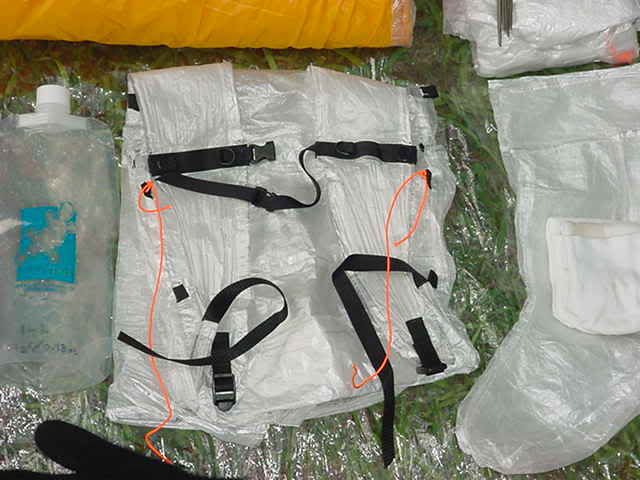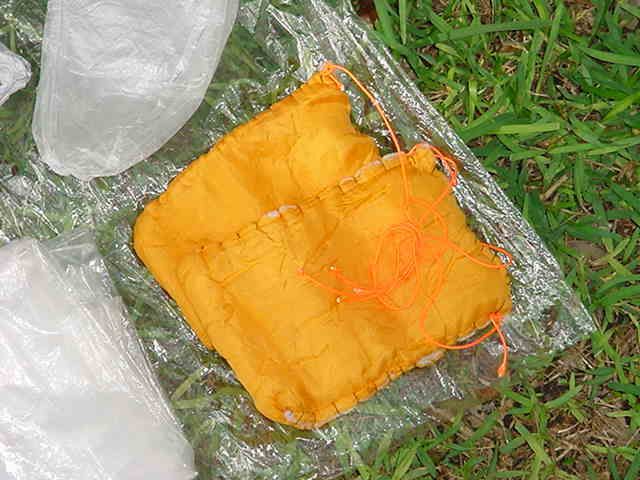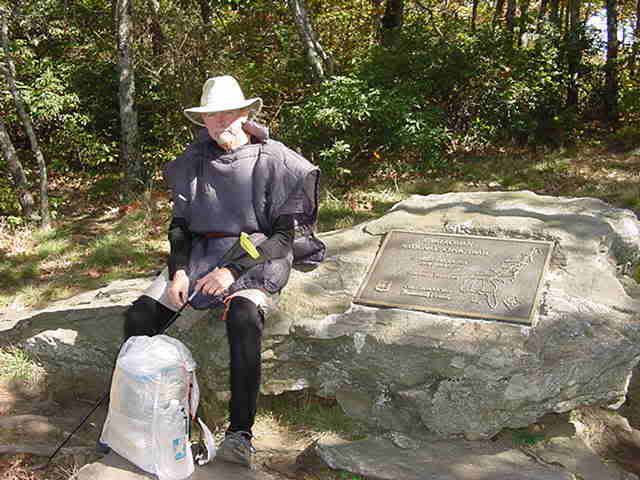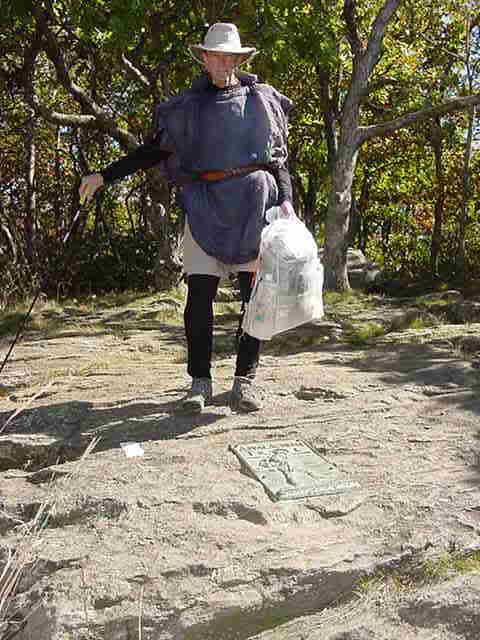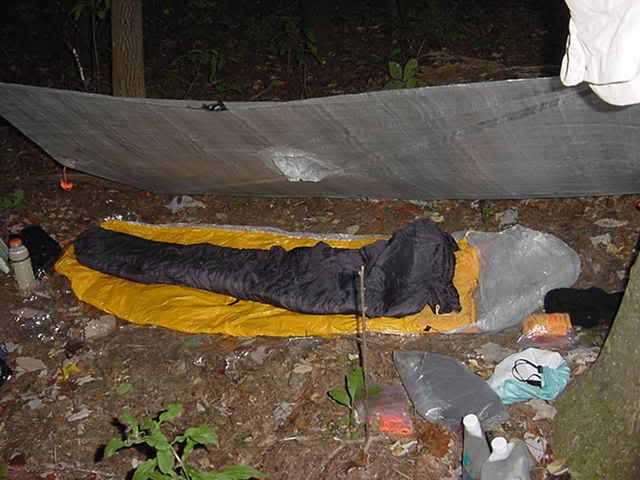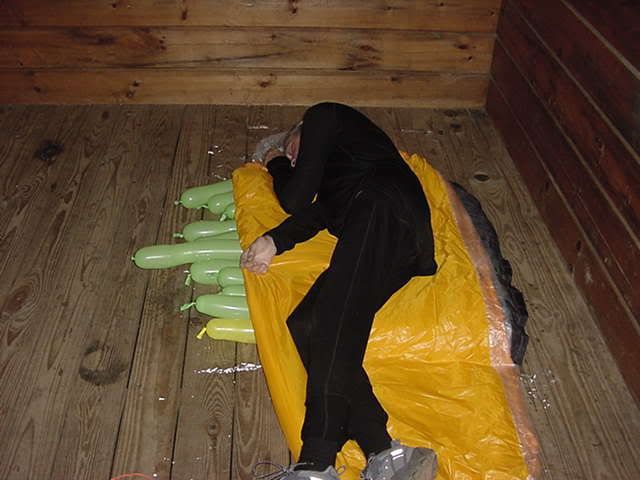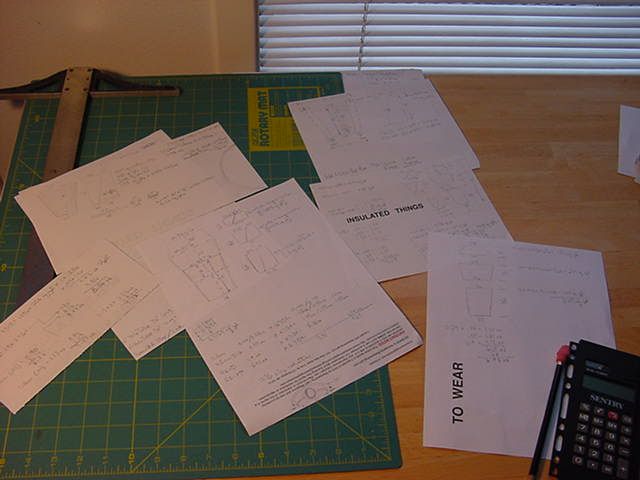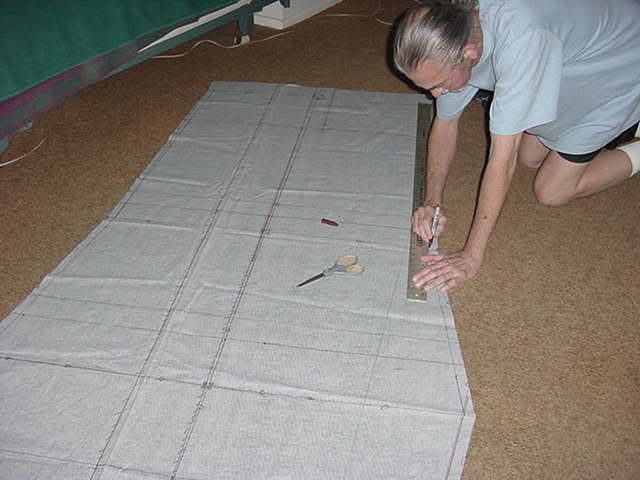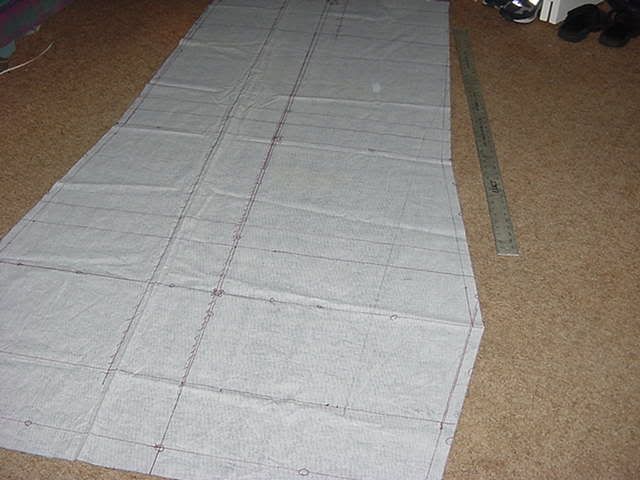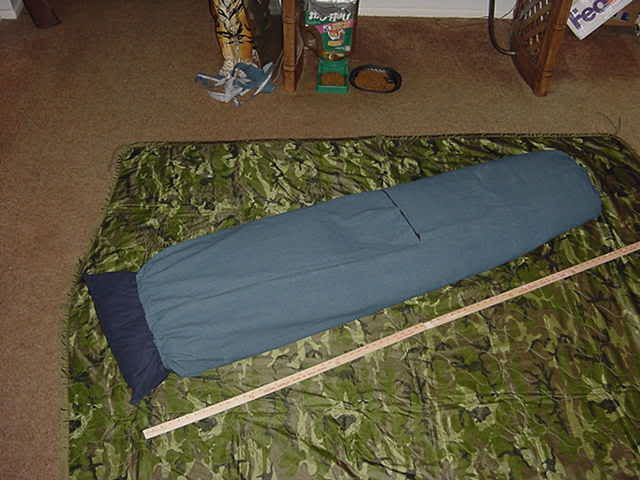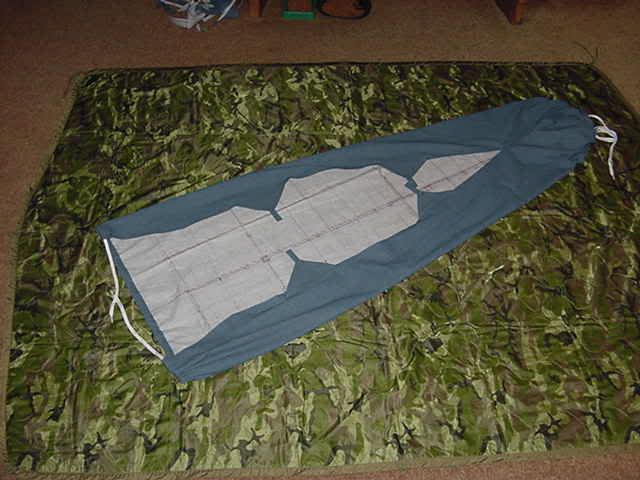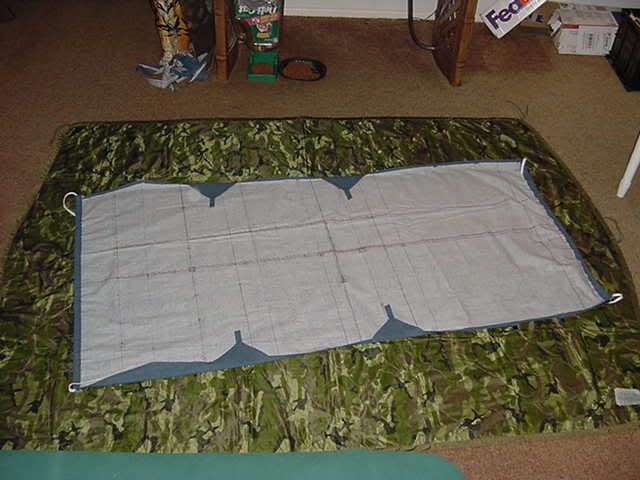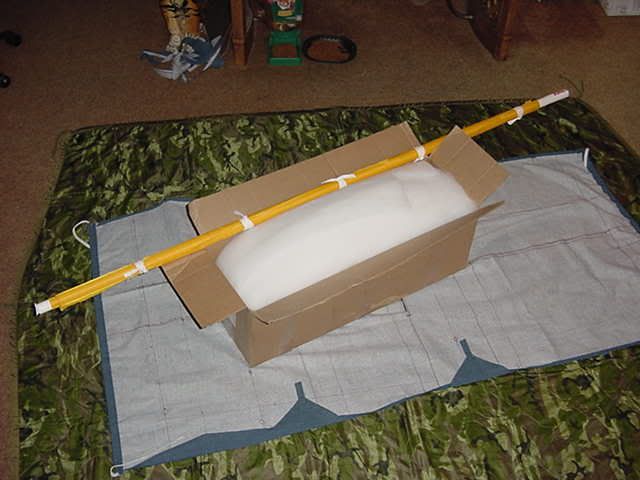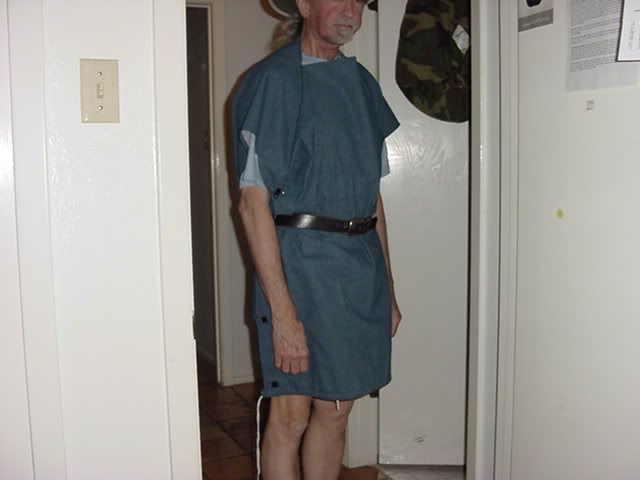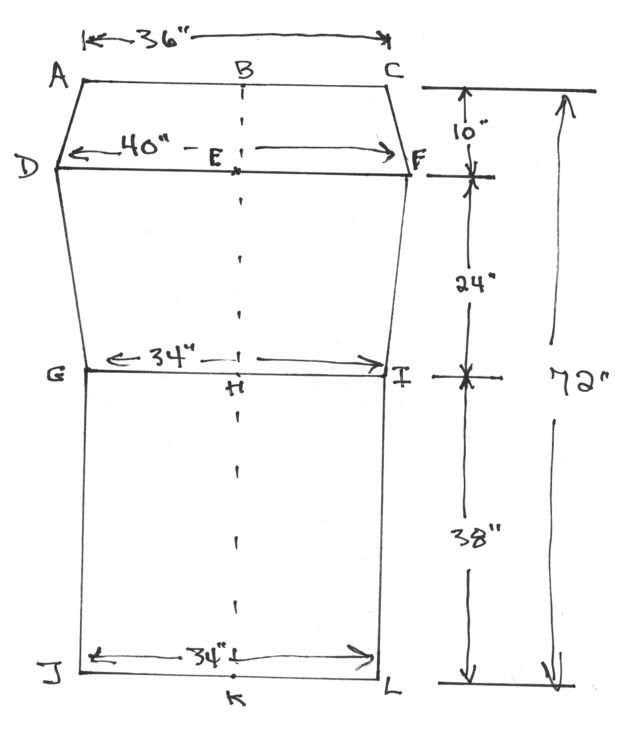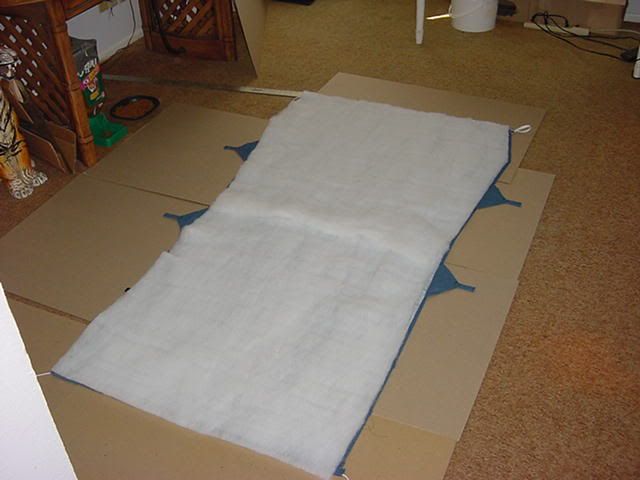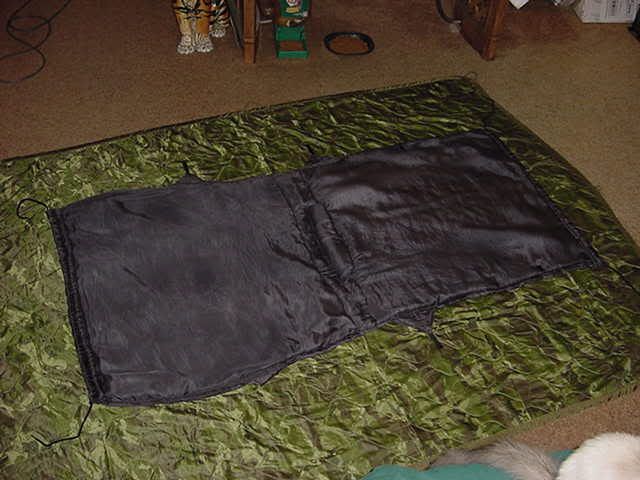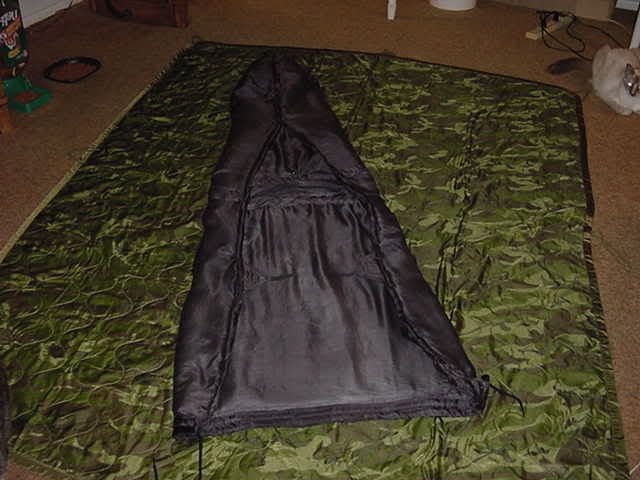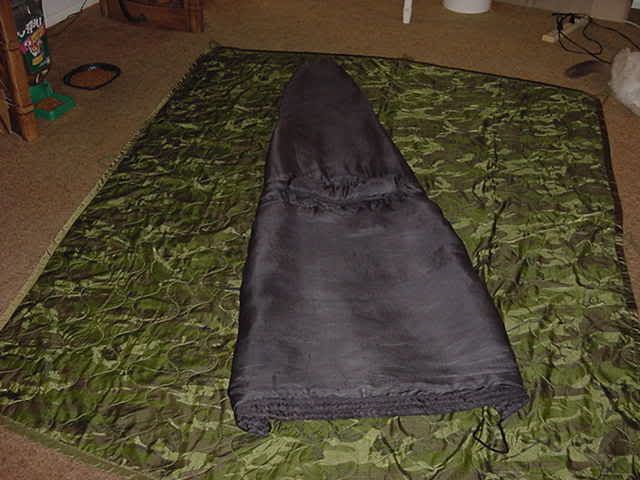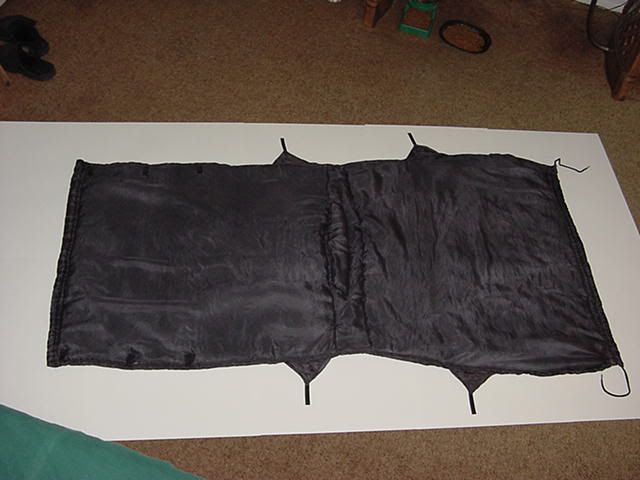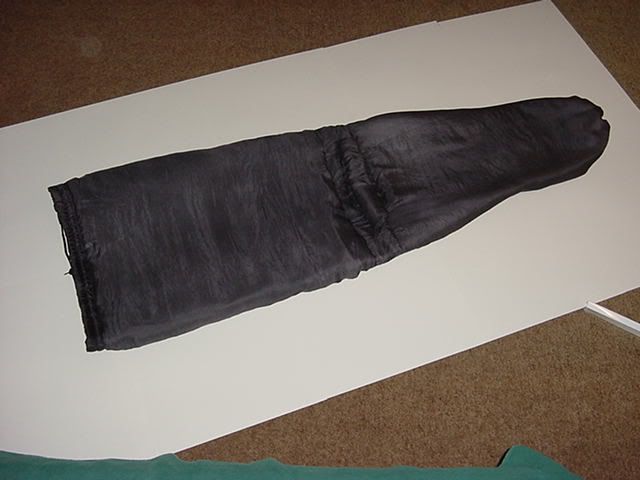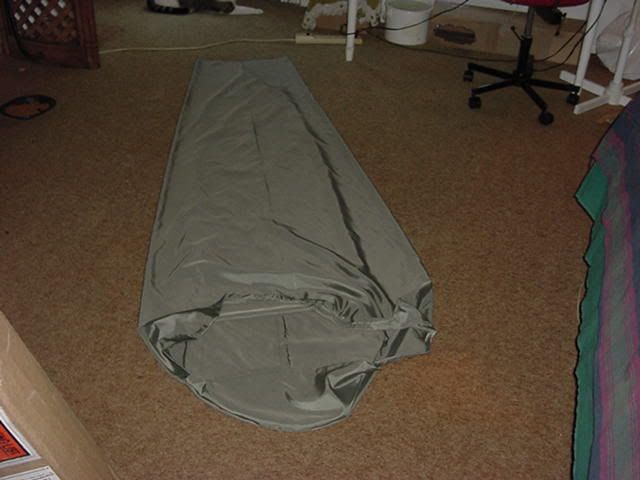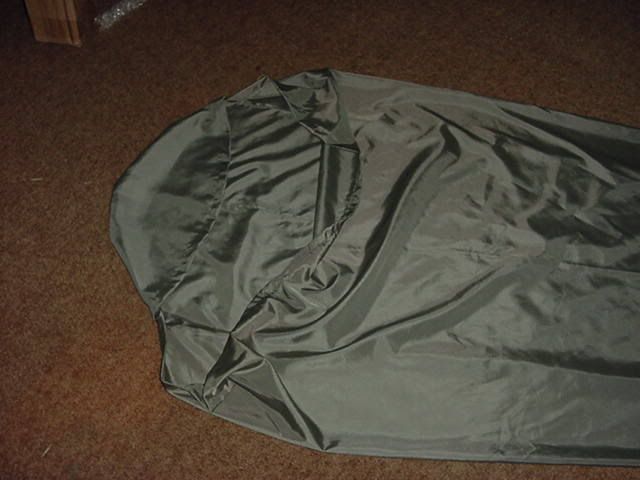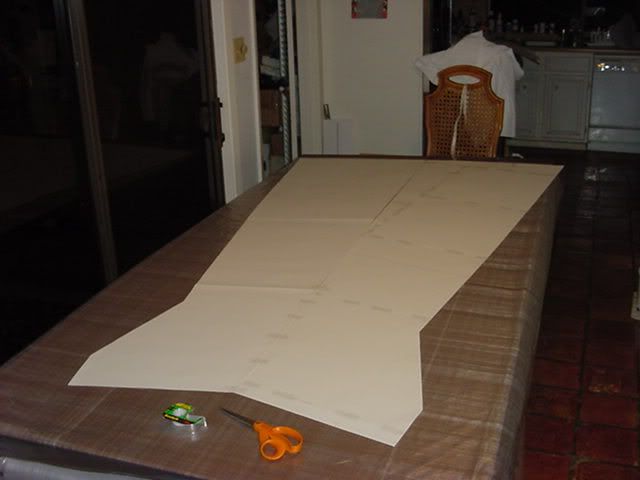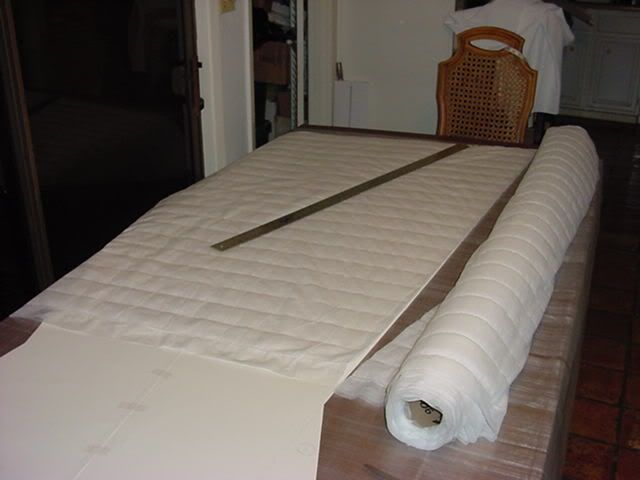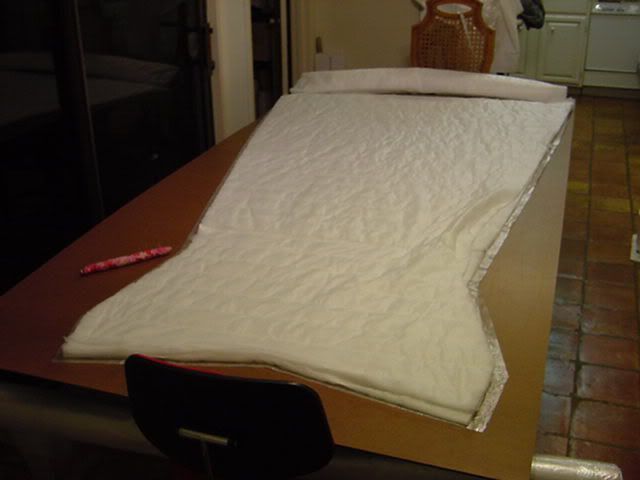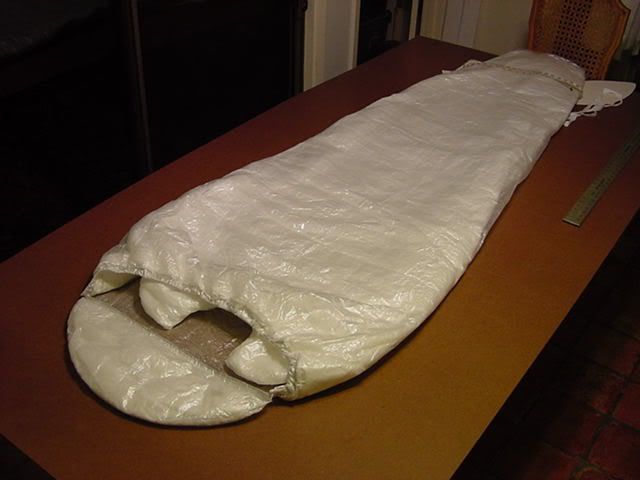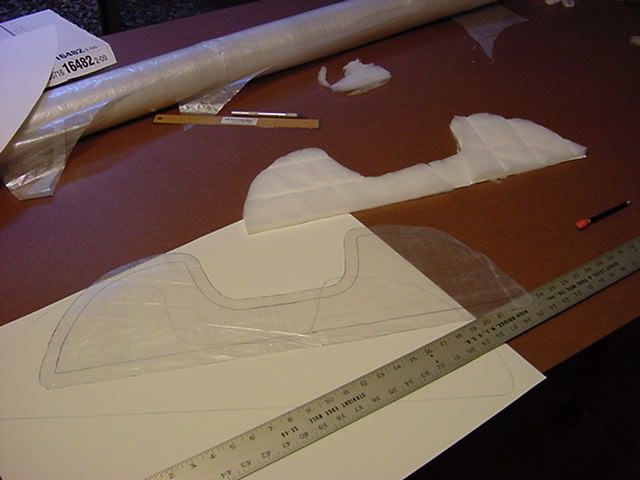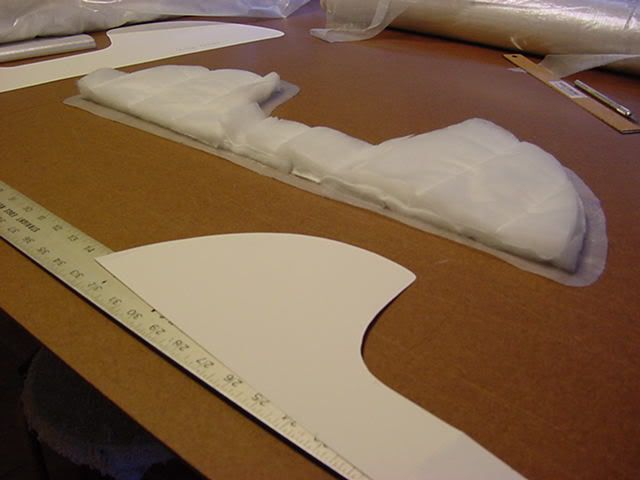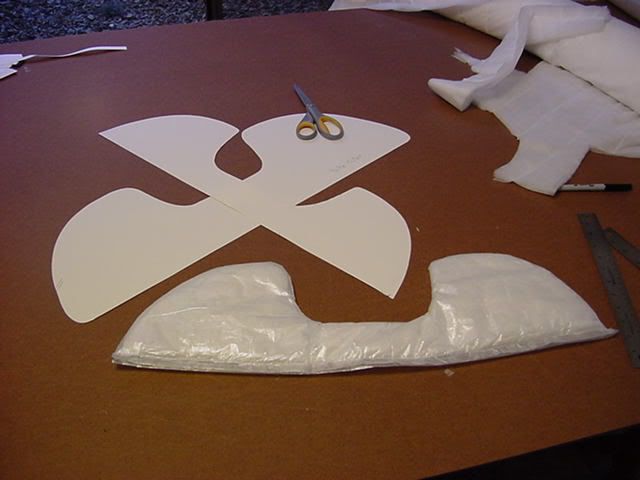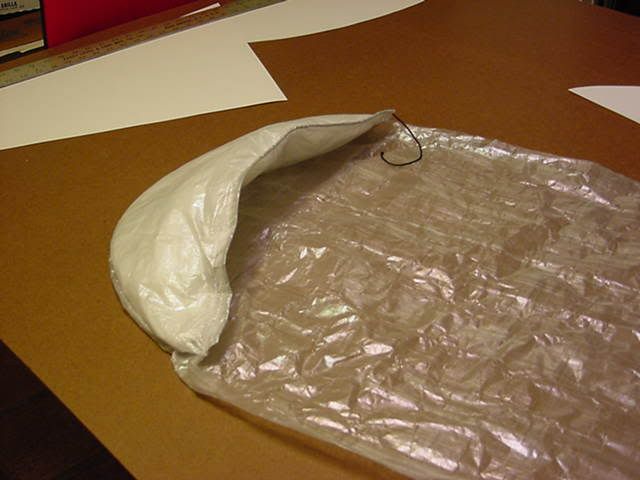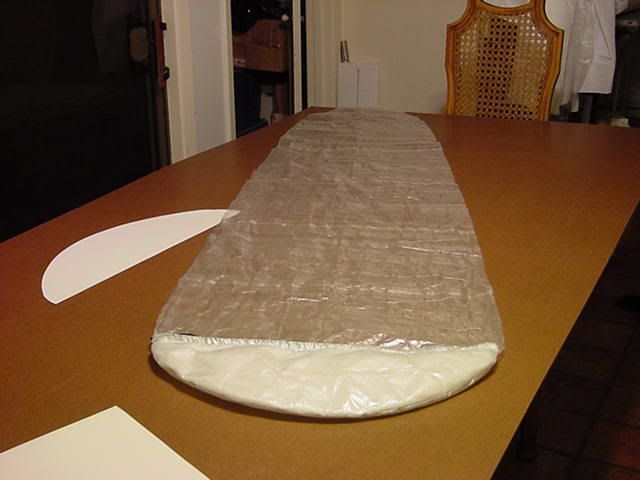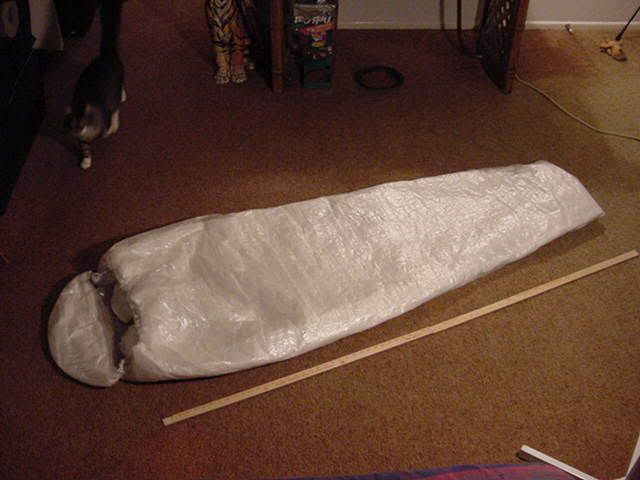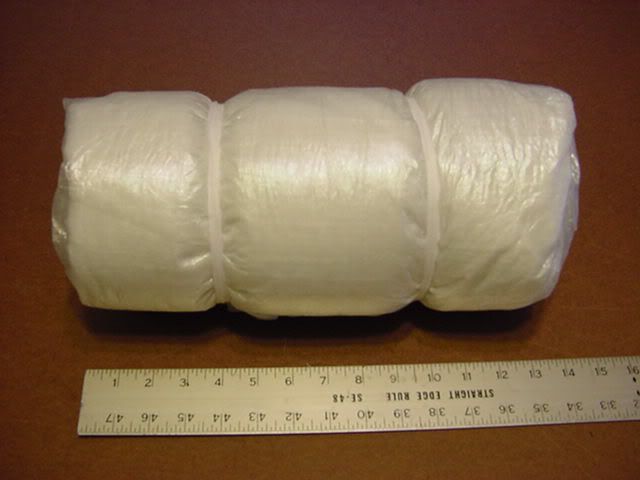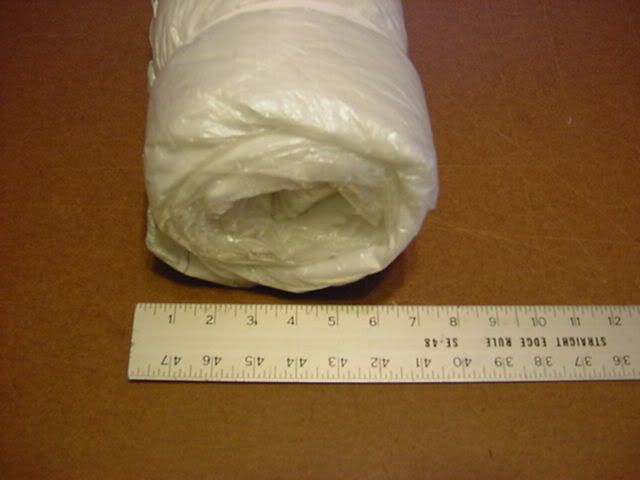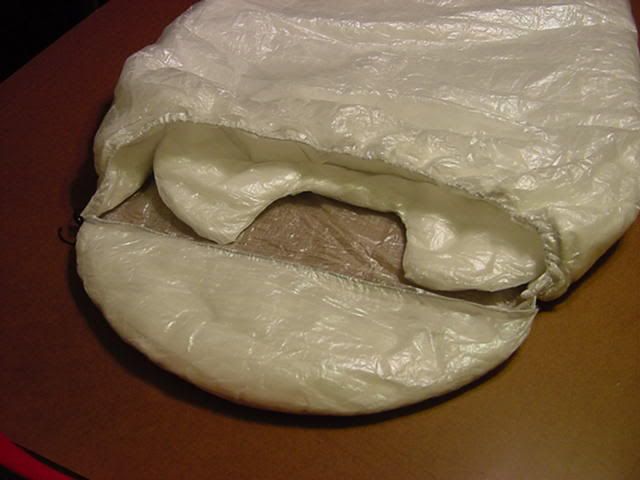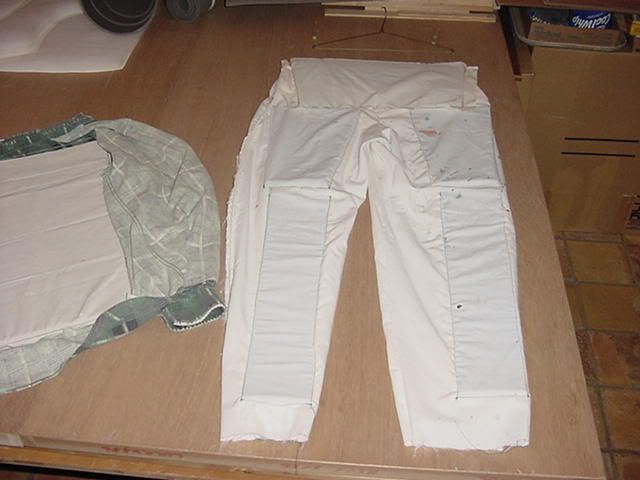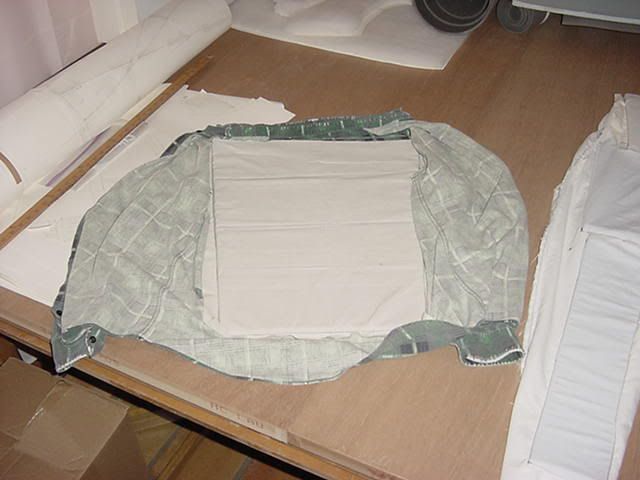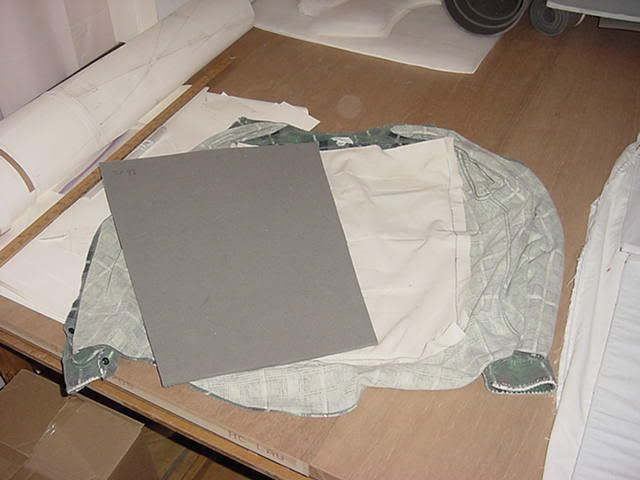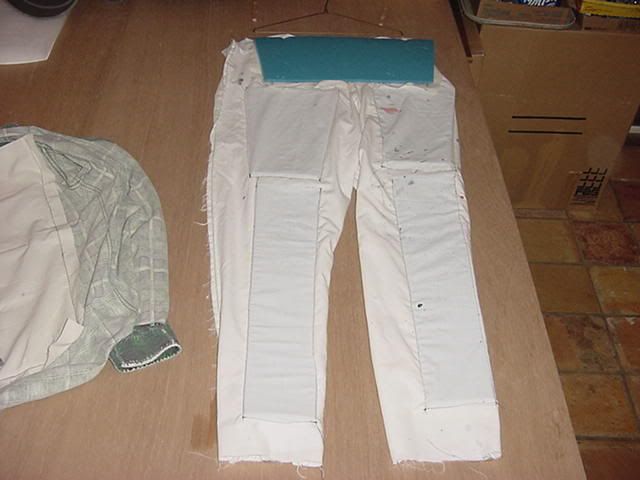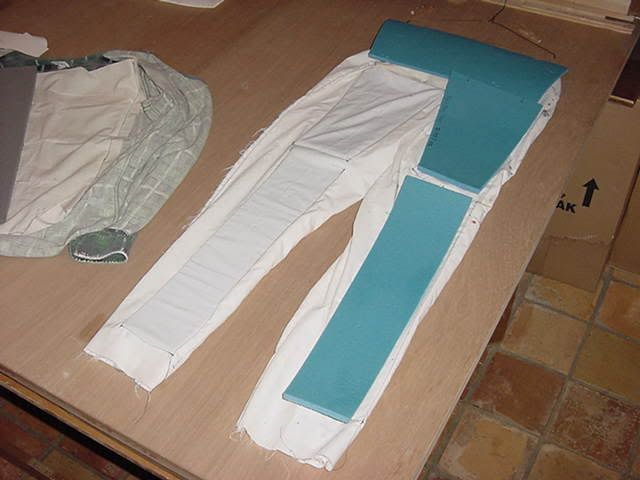Topic
Back to the Future-oops-Super Ultra Light
Forum Posting
A Membership is required to post in the forums. Login or become a member to post in the member forums!
Home › Forums › Gear Forums › Multiple Use Gear › Back to the Future-oops-Super Ultra Light
- This topic is empty.
-
AuthorPosts
-
Jan 24, 2008 at 6:30 pm #1226918
Back to the Future – oops – Super Ultra Light (SUL)
Threads about "real" Super Ultra Light Gear, SUL Gear Lists, SUL techniques etc. have diminished over the last couple of years here to only a few once in awhile. There are still a few of us, however, quietly working away on our ideas, our SUL – MYOG projects and occasionally posting something about them.
I hope this thread sparks some interest and ideas from new as well as the older members here. You don't have to at the SUL level to have a good idea that might lighten some piece of gear or garment.
Remember we reduce our pack weight by reducing the weight of one piece of gear at a time. You decide what weight level is best for your set of skills but dropping a bit of weight for most anybody can be very easy.
Make Your Own Gear (MYOG):
In my first version of SUL I discovered that the fastest way I could lighten my gear weight was by making some, much, or most of my own gear. It didn't happen over night but as I found lighter materials to work with such as Carbon Fiber and Aluminum hunting arrows, other Aluminum, Titanium and Cuben Fiber it became almost easy for me to make a good set of SUL gear. My goal was a SUL gear list for moderate weather, hiking on trails such as the AT.The Sequel:
Then in the first sequel, playing with gear design and a few other ideas and again using Carbon Fiber, Aluminum, Titanium, Cuben Fiber and other light fabric I was able to get my gear list weight well under the 5 pound mark. I was even able to give it a test on a short AT hike at Sub-2 pounds, in cool but moderate October weather in North Georgia. I was questioned by a few of the hikers I saw as to the durability of my very light gear and ask if I thought it would hold up on a really long hike. Yes, I thought it would hold up as well as most of their gear.The Trilogy:
Like the movie "Back to the Future", the Trilogy continues with what I hope proves to be the most versatile of my SUL gear to date. The new SUL gear and a new concept of layering that I have been working on may get its test on a very long continuous hike such as 1000 miles or so on the AT. Like the movie I am back with what I hope will prove that the best was saved for last.I am trying to work out a hiking window that would be from around the end of April until mid-September. This should give me enough time to complete the Appalachian Trail if I can start by the end of April and if I decide to go more than the first 1000 miles.
Over the next couple of months I am going to revise and repost a lot of my older MYOG threads and update (code word for lighten) them where possible. It will also give me a chance to test the new gear and a few other new ideas I am working on. One of the nice things about San Antonio weather this time of the year is that it is much like early spring along the southern part of the AT. This gives me a chance to test my new ideas in a temperature range like I might find on a late April hike start and a mid September hike end.
I invite you all to jump in here if you have an idea or comment that you would like to pass on.
Jan 24, 2008 at 8:38 pm #1417616Bill,
I seem to remember somewhere you made a cuben-pack which used a single layer of heavy-duty CF for the harness.
Adventure racing/running packs out there really aren't all that light, and could possibly do with a cuben treatment.
Loads of course whilst small, need to be stable, and have a very comfortable, supportive harness for running in.
How do your cuben shoulder straps breath?
Have you ever thought of making a pack specific for such activities…?
Cheers,
Adam
Jan 24, 2008 at 9:15 pm #1417618SUL hydration pack from the lightest cuben, target weight 2 oz or less. Cuben shoulder straps, spectra cord compression, 500 cubic inch extra space in with the bladder, and a couple little pockets in front either on the shoulder straps or a cuben hipbelt. Use the "disposable" MPack bladders for the absolute lightest hydration pack out there. Then invent some SUL water. I'll need to round up some scraps or get some more silnylon and start playing with patterns for this! My Camelback is just SO heavy…
take my 1500 cubic inch 2 oz silnylon single shoulder strap daypack and make it from cuben for potentially a sub 1 oz daypack!!!!
Liberty Ridge Jacket with full zip and hood made from the lightest cuben for raingear, for those that aren't into poncho-tarps.
For a 2-3 day trip, go sub 2 by sleeping during the day, and not for long, or taking occasional cat-naps as needed. Leave the sleeping bag, shelter, and cooking gear, just bring the day stuff and some extra food. This is really just unsupported ultrarunning.
Jan 24, 2008 at 9:16 pm #1417619Hi Adam,
The Cuben product I used for the shoulder straps on that pack like all Cuben is not breathable. But it is strong enough that my straps are not very wide and the way that frame is made I can adjust the straps so they don't really touch my shoulders. I am not sure that system would work if the person wearing it was running.
I have wondered why no one has tried Cuben fiber for Adventure Racing packs or it may be that I just don't know about it. Any "Adventure racing/running pack" being sold could be cloned in Cuben and cut the weigh of the pack by a lot.
I have never made anything to sell but If I was into "Adventure racing/Running I am sure I would be wearing a pack I made out of Cuben fiber.
Jan 24, 2008 at 9:28 pm #1417623Hey Jeremy,
I did this for the JMT and it worked, 212 miles.
Although if you have to stop at night it gets mighty cold…Jan 24, 2008 at 9:48 pm #1417625Hi Jeremy,
You have the right idea. Those are some good ideas.
I have already made a pair of Cuben pants that weigh 1.2 ounces that I am trying as Vapor Barrier / rain pants. I wore them on a 2 mile walk yesterday at 38 degree F temperature. I did have to wear a pair of silk boxers with them to cover – well – you know what. My legs were warm enough and when I took the pants off my legs had just the slightest bit of dampness on them. I have snaps on the legs but didn't think about venting them a bit.
I am going to make a cuben shirt to try as a VB shirt/ rain shirt.
My first Cuben pack was just a bit larger than a G6 and it weighed 0.96 of and ounce.
The hike I want to take this light gear list on would be at least 1000 miles long and would not be a race and would not be at night. I am just a bit to old to try and run a 1000 miles and hiking at night would not prove the point I want to make. But some of you out there might like to try that.
Jan 25, 2008 at 1:56 am #1417640Hi Bill
Just because most don't post any comments it does not mean that your work goes un-noticed. I never heard of cuben fiber before seeing your projects. Still I don't have any cuben fiber gear but your various projects do have an impact on my "what if" way of thinking. For example I often thought about the possibility of using a rain jacket and pants as "vapor barriers". Add my beloved merino base layer and the Mont Bell jacket ( or your version) and you have a pretty versatile three layer system (for day and night) Since I have very little experience with sub-freezing backpacking that has not been a priority for me, but the thought is there. Because we live in a "it's not my fault" litigious society, don't expect any of the mainstream brands to come up with your kind of gear, again not because it is not "practical" but because you would need to pass a test and sign a release form before using it. So please keep coming up with your version of UL gear and I really hope that you get to enjoy the Appalachian Trail.
FrancoJan 25, 2008 at 5:59 am #1417651Bill,
I suggest posting your gear list and each one of your MYOG items is a link to a blog post and/or forum thread describing how you built the item and your learnings.
I know what you make is SSUL, but it would be nice to see it all in one place.
Then, when the BPL gods figure out how to "Sticky" threads, we can sticky it as "THE" SUL gear list.
Jan 30, 2008 at 9:35 pm #1418508I have only been a member of this site for 7 months or so, and only find bits and pieces of Bill's creative genius. I too would like to be able to find all of Bill's (and anyone else's) concepts of SUL in one place. I see these radical pictures of Bill wearing some… well… I'm not sure what it is exactly… and I see a picture of his gear layed out on the ground, and I want to know what it all is and how it works.
Let's make this happen!
Jan 30, 2008 at 9:49 pm #1418509Sub 2-lb October Hike – 2006
This is my final hike ready Sub 2 – lb Gear List with few pictures of the gear spread out. The gear is laying on my GG Ground Sheet.
==
Final – Sub 2-lb Gear List – 13 Oct 2006
Weather range for the next 4 days. Lows down to 35, highs up to 65. Windy, clear and sunny.1- PACK – SHELTER – SLEEPING: As of – 13 Oct 2006
Backpack Cuben Pack – Modified w/Sternum Strap 1.97-p
Pack liner – GG – Pack liner – M 1.35-p
Sleeping pad Balloon Bed (12 to 19 balloons & Kilt Shell) 1.96-p
Shelter Poncho/Tarp 2.80-p
Shelter support (Using trekking poles) 0.0
Stakes (6) for Poncho/Tarp 1.23-p
Guylines for Poncho/Tarp 1.42-p
Sleeping bag Quilt/Tunic – counted as clothing 0.0
Bivy Sack 3.00-p
Ground Sheet GG Polycryo Cloth (m) 1.65-pTotal weight in pack – 15.39 oz
2 – CLOTHING: As of 13 Oct 2006
Kilt Home-Made Kilt (counted w/balloon bed)-p
Base layer top Patagonia #2 Wool Crew 6.7-w
Base layer bottom Pat. #2 Wool Bottoms 6.34-w
Insulating top PG-D Tunic/Quilt 7.82-w
Raingear (hard shell) top Poncho/Tarp-p
Windgear Use Poncho-p
Warm gloves Possumdown 1.37-p
Socks-wear Wright-Sock 1/4 2.77-w
Spare socks Wright-Sock 1/4 1.68-p
Insulated Toe Cozy's 0.67-p (see picture below)
Trail Runners TNF Ultra 102's 28.34-w
Tilley LT6 Hat 3.25-wTotal weight in pack – 3.72 oz
Total worn – 55.22 oz3 – COOKING – WATER: As of 13 Oct 2006
Stove N/A 0.0
Windscreen N/A 0.0
Fuel bottle N/A 0.0
Matches/lighter Strike anywhere matches 0.2-p
Cook pot N/A 0.0
Cook pot lid N A 0.0
Drinking mug 12 oz Soda Can 0.42-p
Utensils Home-Made Ti Spoon 0.23-p
Food storage bag Zip Locks(?) ?
Bear bag hang system N/A 0.0
1 Liter Platy "bottle" 0.78 x 2 = 1.56-p
Water treatment – Mirropur MP1-Tablets (15) 0.41-p
Esbit Tablets 1 each (.5oz) 0.5-pTotal weight in pack 3.32 oz
4 – MISCELLANEOUS ITEMS: As of – 13 Oct 2006
Flashlight/headlamp 1 white photon with small Swiss Army Knife 1.07p
Trekking poles (1) Home-Made Trekking Pole 3.2-w
Headnet (if necessary add 0.33 oz) 0.0
Bug dope Out of Bug Season 0.0
Blistex Ultra 1.0-p
Toothbrush toothbrush 0.2-p
Toothpaste (use Dr. Bronner's) 0.0
Alcohol hand gel Dr. Bronner's soap 0.2-p
Toilet paper 8 squares per day 0.5-p
Potty trowel Home-Made Ti 0.31-p
Blister & minor wound care 1.06-p
Chem Heat Pack 2/1.38-p
Whistle 0.1-p
Firestarting kit 0.2-p
Repair (included in with first aid) 0.0
Watch – Timex Alarm 2.5-w
Compass (on watch) 0.0
Maps and permits 1.0-p
Camera (?) ?
Journal kit (?) ?Total in pack – 6.22 oz
Total worn – 6.7 ozSub Total (1+2+3+4)
Total in pack – 28.65 oz
Total worn – 61.92 oz5 – CONSUMABLES: As of – 13 Oct 2006
Food 2.5 days at 1.25 lbs 60.00 /3.75 – lb
Water 2 L average carried 64.0 / 4-lb
Fuel 0 – No Hot Meals – Liquid Diet 0.0
MedicineTotal – 7.75 – lb
6 – TOTAL: As of 13 Oct 2006
Total in Pack – 28.65 oz
(Weight available for (?) items "in pack" = 3.35 oz) (Sub 2-lb = less than 32 oz)Wear / Carry – 61.92 oz
Consume – 124.00 oz
214.57 oz / 13 pounds – 6.57 ozTotal Hike Weight (Naked Weight) = 149 lb
Total Hike Weight (On my body Weight) = 13 lb / 6.57 ozTotal Weight on my feet – Start Day 1 = 162 lb / 5.70 oz
What was in the Sub 2 – lb Pack:

My Cuben Pack modified with a Sternum Strap:

My Insulated Toe Cozy's. These were made in GA after a cold toe night on the first hike. I had taken a scrap "cut-off" piece of my Bivy Liner to use as a neck wrap. I cut it in half – hand sewed the sides and added a cord to each so I could tie it around my ankle to keep my toes warm at night. They were really easy to make and worked great.
My toes had gotten cold on the 42 degree night when I slid off my sleeping pad just enough for my feet to be on the cold ground. My cold feet woke me up and I put my Cuben booties on with my second pair of socks over them. I fixed my pad and went back to sleep. The toe cozy's weigh 0.67 oz.

===

Top row Left to Right:
Pertex Quantum / Cuben Bivy with the Climashield Combat Liner attached.Cuben Poncho/Tarp with 6 Ti tent stakes and guylines made from 1/16" Yale Cordage "Pulse" line.
Next row: Left to Right:
Black Kilt/Shell for Balloon Bed and bag of Balloons.Shop Towels cut for TP with my Ti Trowel and BMW small bottle of Dr Bronner's soap (brown cap).
Under Shop Towels are my Micropur MP 1 Purifier Tablets.
Platy 1 Liter water bottles (2).
Cuben Pack modified with sternum straps.
Cuben Booties with spare pair of socks laying on top. Socks were used for padding in my shoulder straps.
Next row Left to Right:
12 oz Diet Coke can used to mix and drink my liquid Dry form of Ensure and my home made Ti long handle spoon. The spoon handle is pointing to my Food Bag.
Zip lock with my Blister/Wound care stuff, Blistex and Tooth brush.
Zip lock next to my gloves has my Matches, Esbit tablet, Firestarting kit, Chemical heat packs.
BMW Possumdown gloves.
Wool Watch cap.
GG Pack liner.
Climashield Combat Toe Cozy's.
1- Everything is laying on my GG Polycryo Ground Cloth.
2- Counted as in my pack but attached to a belt loop on my pants is my Photon LED and small Swiss Army Knife. The knife got left off my gear list and weighs 0.72 oz. I have added it to the gear list as in the pack.
3- The whistle is hiding on the pack and didn't show up in the picture.
==
Springer Mt – GA – AT. Oct 2006 The temperature was 35 degrees that morning.


Along the Duncan Ridge Trail, GA – Oct 2006


Balloon Bed at Woods Hole Shelter – GA AT. Oct 2006
 Jan 31, 2008 at 7:16 am #1418530
Jan 31, 2008 at 7:16 am #1418530To those of you that are new to the site, Let me tell you that you should take a day or two and pour back through the threads for the ideas that Bill has brought to the table.
If I look at my personal journey to SUL, and I'll only talk about quantum leaps of thought I've made, I'll say that it started with Jardine, His book "beyond backpacking", and his kits. Mixed in with a healthy dose of Colin Fletcher. This took me below 10 lbs baseweight.
The next leap of thought came from this site and Jordan's book on the subject. The one chapter on SUL was an eye opener. This took me to a 6 to 7 lb baseweight (I'm a bit larger fella than Ryan).
Next was Glen Van Peske and his thoughts on the subject. This took me below 6 lbs.
Then came the ideas of Bill Forshell. Bill, I would encourage you to put your plans, thoughts, and concepts in book format. I know I'd buy a copy.
Bill started, in my opinion, the cuben fiber revolution in backpacking. His ideas have challenged my thinking and have pushed me to a sub 4 lb gear list for summer use.
But here's the real rub. The piece that many don't understand when it comes to modivations for SUL. When you've got an honest 5 lb or so baseweight for three seasons you gain tremendous flexibility in packing for any given trip.
I mean … if I'm headed into a lake to hang out for three days, it's not real hard to toss in an extra pound for an inflatable pad and chair kit and even 2 lbs for my travel guitar. It's as effortless to hike with some "extra" comforts as it is without them.
For example … In November I took a week long section hike on the AT. My total pack weight for a week long trip was 22 lbs, including two liters of water, food, and fuel.
I carried a stove. I carried a Gatewood cape. I carried a paperback book. And I ate good for the week. I even used a ULA conduit pack for the trip and carried a full Liter of good Scotch!
I was toasty warm with temps in the 20's, I was well fed, I was well hydrated, and I was comfortable sleeping at night.
This is all due to a shift in my thought process.
To that end … that's what SUL really represents. A shift in a way of thinking that's enabled me to become much closer to nature and have a much higher enjoyment of my outdoor experience.
So … take the challenge. Change your thought processes. Challenge yourself to learn.
Jan 31, 2008 at 11:36 am #1418562Thank you Bill for posting this clear and concise list with pictures. It helps a lot.
A couple things I'd like some more clarification on. The Tunic/Quilt seems to be one of the big steps to going as light as you are. Could you tell me more about how it works – i.e., how you convert it from the Tunic into the Quilt.
Also, could you elaborate on the balloon pad concept? I assume you untie the balloons and reuse them the next day? How do you keep the balloons from sliding all over the place and separating when you lie down on them? Also, is it a long process to "set up" and "take down" the balloon pad?
Jan 31, 2008 at 11:27 pm #14186697.65 ounce Polarguard-Delta – Silk Tunic / Quilt
Started on 08/27/2006.
This thread was first started at here at BackpackingLight.com and the full thread with all comments can be seen here:
1.
I have been playing with the math for a very light quilt that will be NO larger than necessary for my size. Unlike some folks that are not as tall and wear smaller sized cloths and shoes, I am 6' tall with long arms (think XL upper body garments) and wear a size 11 trail runner. Anyone that wears larger than a size medium and size 9 shoe should get some kind of "handicap" like golfers get. I know that this has been talked about by some of our SUL Hikers and someone we all know was once so generous that he let a taller person hiking with him take (ONE OUNCE) off his weight total.
How it all starts:

Before starting this Quilt I looked at as many different ideas for quilts as I could and read about what others were using. I spend a lot of time planning my projects and do a lot on paper before I cut material. For this quilt I spent a couple days working out all sorts of different ideas for the size I needed and the material weighs. My weight goal is 7 ounces or less. I am using 1.9 oz per sq yard Polarguard Delta as my insulation. For the fabric I am using Cuben and light Silk. This is the only combination I have materials for that will give me the low weight I am after. I don't know how the Cuben will work used like this but I will find out on my hike in October. The Cuben will be on the outside and I think it will work OK.
This afternoon I started the Prototype. For this Quilt I am making my Prototype out of some $1 a yard denim from Wal-Mart. You can see a lot of lines on my material as I made different changes right up to the time I cut the material. I expect this quilt to be on the easy side vs some things I have made. The time I spend on the Prototype will make the finished Quilt go fast.
Prototype:


2.
The issue of the using the Cuben material has plagued me ever since I thought it was the only way I could stay under the 7 ounce goal I have set. I have been scheming for a way around the Cuben material ever since I posted the remark about using it. If I expected to be cold enough for a vapor barrier to work the place for the Cuben would be on the bottom. One layer of PG – Delta or Climashield XP would not keep me warm alone if it gets very cold. What I want is something for a temperature range down to maybe 45 to 50 degrees. My pick of clothing would support my sleeping system and I could go to "Down". I have a few reasons why I want to try one of the two synthetic insulations listed.
The end result of working through this all afternoon and up till a hour or so ago is that I have "Down-Sized" the Quilt a little more. I have some Pertex Quantam and have gotten the Quilt "square yardage required" down enough to go with the Pertex Quantam for the top and Silk for the bottom. Adding one layer of the 1.9 oz PG – Delta brings the total material weight (on paper) for the Quilt to 6.46 ounces. This gives me a little extra for the other things necessary and should still stay under my 7 oz goal.
I have a bit of Climashield XP and it is easy to buy in small amounts. Being a new generation insulation, when dry it is a much better insulation than PolarGuard Delta. As more Climashield XP is used it may prove better than PG-Delta when wet. However, for now if I think I might get wet I want my insulation to be PG-Delta. One of the things I want to do is make a quilt like this one but with Climashield XP. Then I can do some testing for myself.
The question of how much or how thick the insulation needs to be for a given temperature when using one of these synthetics seems to be divided into several ideas. Down goes by loft and a synthetic goes by ??? This is where it gets interesting and I am not smart enough to really understand. That is why I want to do some of my own testing.
I am sure that my Cocoon top and bottoms are good much lower than 70F. I will be up in Georgia in October and if it is cold enough I will be able to see how warm I am with the Quilt and a few other things I am taking to test. I will not be far from a warm bed where I will be testing my stuff. Then if it seems to be good enough I will go on a hike for a couple of days. Still close enough to bail if I get to cold. I use the old indian way to see what the rating of my insulated stuff is, am I warm in it, yes or no. How much other stuff do I need to put on to get warm. Do I need to go to a warm house now.
3.
How to figure the amount of synthetic insulation needed for a given temperature range.
Note: Like working with Down these are "ball-park" numbers and field testing should be done to test the amount YOU need for any given temperature.
I have both Polarguard Delta (PG-D) and Climashield XP (C-XP) synthetic insulation. The information I have for the Clo value of the the PG-D and the C-XP came from Brian Emanuel, Director of Sales for "Western Nonwovens" the company that makes both of these two products. The Clo for PG-D is .67 to .68. The Clo for C-XP is .77. To get an idea of the temperature range for something made from one of these (this is a ball-park number) you weigh a sample piece of the insulation. I cut a 6" square of each and weighed them on my gram scale. the PG-D I have came out 1.9 ounces per sq yard. The C-XP came out 2.41. The PG-D was about between 1/2" to 5/8" thick. The C-XP was 3/4" plus a bit.
Working first with the PG-D I take the weight per sq yard of 1.9 ounces and multiply that times the Clo of .68 and get 1.292 . This number equates more or less to the typical loft rating like we use with Down. With 1.292" (for want of a better word) loft and looking at the table in "2006 Revision by Mike Martin -Backpacking Light Position Statement on Sleeping Bag Temperature Ratings" it would seem that this would give me a bottom temperature range of 50 degrees "F". We all know that this type of rating is just a base line and maybe high or low for any given person. It does provide us with a number to work with.
When I did the math for the C-XP at 2.41 ounces per sq yard times .77 I get 1.848" loft??. The extra weight of the C-XP (0.51 oz per sq yard) gives me 0.556" more loft per sq yard of insulation. With one layer of this C-XP my base line temperature low should be 30 degrees "F".
What can I do with this information? Well, if my new quilt was made with PD-D I might be able to use it down to 50 degrees "F" ???. If I wanted to use C-XP I would only add 0.97 ounces and might have a low temperature range of 30 degrees "F" ???. Add less than 1 ounce total weight and gain 20 more degrees "F" ??.
That would give me a 7 ounce quilt good for maybe 50 degrees or an under 8 ounce quilt good for maybe 30 degrees.
Interesting, but how do I test this to see if my numbers are in the "ball-park". I expect I need to make two quilts off the same pattern, one with PG-D and one with C-XP.
4.
I can not backup in court anything I wrote in my thread. That is why I added the ???. When asked point blank about the use of the Down chart I was told to realize that a whole lot goes into a rating like for a sleeping bag or what ever before it goes on the market. In other words it is hard to be real certain because of other factors. Type of shell material, type of lining, type of construction etc. I was told that the Down loft chart for Down stuff is only a "maybe" at best for the same reasons. It does however give a person a starting point. These folks product a material (PG-D, P-XP and others) that (BMW, TNF etc) combine with more material and design considerations to market a product.
But that if I error on the conservative side, the way I wrote in my post the number should be good enough for planning/testing. Testing is the key. You may also note that I added "ball-park numbers" several times.
I asked them to look at the other thread where the Clo was talked about. I was told that the other idea for the math was wrong. That is all I want to say about that.
I asked the same question about Down vs this insulation but could not get a real answer. I did get that PG Delta is really great if you expect it to get wet. Not enough testing has been done with the C-XP yet or no one is talking about it to say if it is better, yet. I was really surprised that I was given as much information as I was. They said over and over that the new stuff they are making today is good, really good. That XP is the best synthetic insulation on the market but it is new and it will take a year or so to prove itself.
It may be that this new generation of synthetic insulation will come close to closing the gap with Down. I don't know. For me it is mostly about weight and if I expect to get wet. I really love Down, most everything I own to keep me really warm is down.
As for a direct equivalent to Down, I don't know. I asked for some "ball-park" numbers.
My one layer quilt might be OK to 55 degrees.
40 degrees about a Clo of 2 to 2.5.
20 degrees about a Clo of 3 to 4.
0 degrees about a Clo of 6.For most of the answers to these and other like question WE may have to be the ones to prove or disprove what it takes to stay warm with this stuff. The big guys may never want to talk about it.
5.
If you look on the Climashield XP part of the web site at http://www.westernnonwovens.com the Data sheet list 5 thickness for XP. The data sheet lists the following:
2.2 oz per sq yard.
3.0 oz per sq yard.
4.0 oz per sq yard.
5.0 oz per sq yard.
6.0 oz per sq yard.My guess is that what they list as 2.2 oz is what I have but weighed 2.41 oz per sq yard. I think Thru-Hiker has more than one thickness of XP.
Don't give up, the availability of PG-D might get better for us little guys.
6.
I agree that the weight of my sample piece may not be true for the full amount of the Climashield XP or Polarguard Delta that I have. It does however give me an idea of the weight for planning purpose. As I start cutting the material that I use for my projects I weigh and record them to confirm I am close to my planning numbers or I am high or low. Then when I am finished with the (what-ever- project) I weigh it again for my finial finished weight. My scale is a Triple Beam Balance – Ohaus gram scale.
As for "your" term not mine of " REAL WEIGHT" all I said is that:
"I cut a 6" square of each and weighed them on my gram scale. the PG-D I have came out 1.9 ounces per sq yard. The C-XP came out 2.41. The PG-D was about between 1/2" to 5/8" thick. The C-XP was 3/4" plus a bit. "
Anyone but a lawyer should have taken that to mean I took a "sample" and weighed it.
The numbers are only important to ME at this point and give ME numbers for planning the amount of material necessary to reach my given weight goal. Am I misleading myself? I would expect anyone that wants to work with this stuff would sample what they have for "planning" numbers also.
7.
I have settled on a prototype for my first real quilt. I even slept in it last night to see if it was going to be large enough. It fits OK and is about as small as I think would work for my size.



I even got out my Pertex Quantum and box of Polarguard Delta.

I had thought about dying the silk I am using for the liner but I think I will leave it white.
If I can stay focused on the quilt tomorrow I should get most or maybe all of it done.
8.
As for the triangular base things, yes I hope and how about when I wear the quilt as a garment?
If this works where do I count the weight?


9.
I did this drawing and scanned it.

10.
Cutting "My Precious" :
Well that part went easy.



11.
Brian Emanuel
Re: 7 ounce Polarguard-Delta Quilt-etc on 08/30/2006 19:45:27 MDT
Very interesting thread regarding Climashield XP and Polarguard Delta. I am the Sales Director for both Polarguard and Climashield. Beyond a doubt XP is lighter than Delta. Standard testing protocol for basis weight is to weigh a piece 36" x 36". This weight in ounces gives the ounces per square yard of the batting. Regarding temperature ratings, for a given ounce per square yard XP will have a better temperature rating than Delta (~7%). The advantage is you can get a given temperature rating at a lower weight with XP versus Delta. However, Delta will have a higher loft than XP for a given basis weight. We could discuss theory throughout eternity in regards to the impact of loft on temperature rating. Bottom line is that this is a multi-variant optimization in terms of thermodynamic mechanisms (conductive, convective and radiative heat transfer mechanisms). Also, the true temperature rating is highly contingent upon bag/quilt/garment construction as well as shell and lining materials. There's a lot of science involved but it's still mainly an art. Both products, XP and Delta, are exceptional synthetic insualations and from my perspective the best two on the market today. Both are continuous filament so the durability is unsurpassed and even after numerous uses, launderings or prolonged storage they will recover and perform as well as the first time! If you are looking for ultralight weight synthetics we are currently working on a new product, Climashield Combat, that will become available in weights as low as 2.0 ounces per square yard. Good luck with all your efforts!
12.
It sure was nice seeing Brian's comments. I have talked to Brian on the phone several times. He was very nice and took a lot of his time explaining the merits of both types of insulation. I hope to make a number of insulated items out of both the PG-Delta and the Climashield XP.
The best part of all this is that Climashield XP is available in amounts of a yard or more from Thru-Hiker.com. It also is nice to see that Ryan thinks he will have some Polarguard Delta available for MYOG folks this fall.
13.
Richard Nisley:
Now for the controversial part
Insulation clo/oz % loft when wetPolarguard Delta .68 -40
Primaloft Sport .74 -11
Climashield XP .77 -??
Primaloft One .84 -00500 fill down 4.5 -60
800 fill down 2.5 -60Would you investigate a DIY source for Primaloft One? It would be the optimal solution for wet environments. Brian’s counterpart for Primaloft is Arnie Liati in the Primaloft Issaquah, WA office.
Would you let us know what quilt weight you could achieve using 800 fill down for your quilt? It is available from multiple sources and has a much better clo/oz value for dry environments.
My experience with synthetic bags is that I get about a 40% reduction in loft after one season’s use and then they stabilize at that loft. The temperature rating drops and stabilizes accordingly. I haven’t experienced more than 10% degradation in my down bags after multiple years of use. No one on the BPL forums has ever compared the loft degradation history between various synthetics. Would you monitor the loft degradation with your quilt experiments?
From your conversations with the Polarguard folks do you know what the Climashield XP loft reduction is when wet?
You continue to amaze me at the way you think outside the box to innovate. This area is ripe for someone to shake it up with some new ideas.
1. Q – Would you investigate a DIY source for Primaloft One? It would be the optimal solution for wet environments. Brian’s counterpart for Primaloft is Arnie Liati in the Primaloft Issaquah, WA office.
1. A – I could not find anyone that was retailing PL-One. I decided to call PrimaLoft and see what it takes to buy direct from them. I finally found a little time to call and ask. I filled out a form for them and asked about getting a sample of PL – One 1.8 ounce a sq yard insulation. I have had a 5 yard sample request approved and it should be shipped next week. I asked about buying some and pricing but was asked to wait till next week for that answer. They have a one roll (45 yards) minimum if they agree to sell to me. I will wait till I can make a few things with the sample and test them before I buy any if they agree to sell to me. The sample will be enough to make several items to test / compare with the other insulation I have. I will make a Quilt / Liner for my Bivy with some of the PL-1, 1.8 oz a sq yard material so I can do a direct comparison with my other Quilts / Liners.
I want to do more with the Climashield Combat as I have been surprised (good surprise) with that insulation.
2. Q – Would you let us know what quilt weight you could achieve using 800 fill down for your quilt? It is available from multiple sources and has a much better clo/oz value for dry environments.
2. A – I did a little math to see what the answer to this might be but I need to work on it a little more. I need to figure out the sewing for sewn baffles. The way I have worked with Down in the past was with a removable baffle or side-in silk tube of Down. Doing it that way let me use the Down Tubes for other things but did add a little weight. I need to practice making the baffles a different way and when I work that out I can then weigh the material and add the Down weight for a "best guess" answer. It would seem that the Down Quilt / Liner has to be lighter by a bit. The difference might be an ounce or so over the current Quilts / Liners that weigh 6.5 to 7.5 ounces. The total weight for a Down Quilt same size, same Temp range (40 degrees F) might be as low as 6 ounces using my light silk as the shell and liner material.
3. Q – My experience with synthetic bags is that I get about a 40% reduction in loft after one season’s use and then they stabilize at that loft. The temperature rating drops and stabilizes accordingly. I haven’t experienced more than 10% degradation in my down bags after multiple years of use. No one on the BPL forums has ever compared the loft degradation history between various synthetics. Would you monitor the loft degradation with your quilt experiments?
3. A – I don't know how I will do this but I will try an watch what happens over time.
4. Q – From your conversations with the Polarguard folks do you know what the Climashield XP loft reduction is when wet?
4. A – The next time I have a chance to talk to someone like Brian I will ask about this and see what they say.
14.
I funny thing happened on the way to my 7 oz Polarguard Delta Quilt.
Once I cut the Polarguard Delta to the shape of my Quilt I put it on my scale. My planned for weight was 3.69 ounces. My 1.94 sq yards of Polarguard Delta weighed 4.29 ounces. The center part of the insulation was thicker and looked like somewhere in the process it may have lifted some insulation from the layer above or below it when it was made. Beyond that I have no real idea. The good news is that if I use this piece of Delta my per square yard weight is 2.21 ounces. This times the Delta Clo of .68 gives me a number of 1.503 (inches or what ever). That would make the Quilt warmer than planned for by a small amount. If I was using Down in the Quilt and had a loft of 1.5" I would say it would be good somewhere between 40 and 50 degrees (F).
I spent the next several hours crunching the numbers. I even tried a smaller Quilt size. I made a full size cloth prototype. It was sized to come up only to my arm pits. It did that OK but I didn't think it would work for me.
In all my number crunching the only material I have that would still get me close to the 7 ounce mark was some of my light silk. Using 4.5 mm silk (0.57 oz per sq yard) for both the top and bottom I would be over 7 oz by a .5 to .75 of an ounce. That assumed no other surprises.
I finished the Quilt a little while ago. It weighs 7.65 ounces. Accounting for the extra 0.60 ounces of extra PG – Delta I should be happy. I will have a Quilt that will be warmer by a factor of 1.5 over 1.3. It fits me snug with the foot box closed. In my Hammock the foot box as well as the complete right side of the Quilt will be connected to the right side of the Hammock. I think the Quilt will be OK on the ground as a sleep on my back. I got in it to see how the fit was and began to get warm fast. It is 74 degrees in my bedroom.



I really learned a lot about sewing a Quilt. I think I over sewed much more than might have been necessary. I believe I could now make another Quilt from the same pattern and save some weight with less sewing. I should say sewing the Quilt differently.
I did design this Quilt so I can wear it and for a SUL Gear List for cool weather it should do double duty. I think the extra sewing for the head hole accounted for a little of the extra weight.
Weight Breakout:
PG-Delta – 4.29 oz
Silk for Shell and Liner – 2.22 0z
Other – 1.14 – ozCurrent Total Weigh – 7.65 oz
When I make the next Quilt I will weigh all the necessary insulation first and see what it weighs. Then decide what to use as Shell and Liner material.
15.
Some better pictures:




16.
First let me say I really hate Velcro and "almost" never use it.
The foot box is connect with three pairs of hook like things. Then if you see the triangle looking things sewn into the side seams – they will connect to the ones on the other side of the Quilt and hold the Quilt more or less to a sleeping pad. In my case to my Kilt/CheerStic Air Pad "thingy" or what ever I happen to use. The Quilt will also be used in my Spreader Bar Hammock and the Hook things for the foot box will connect the foot end of the Quilt to the foot end of my Hammock. The side triangle things will connect also to the sides of my Hammock. I was going to work that out this afternoon in my backyard but we had a little rain.
I have a BMW Vapr Bivy Sack (Pertex Quantum) at about 6.5 ounces that I think I can put this all inside if I need to for "a moderately-hermetic seal against the night air". I haven't tried this yet and if I don't have enough room I will make my own bivy out of Cuben and Pertex Quantum. I will test this in my backyard and then again in Georgia next month to see how it works in cooler weather. I will take and post some pictures of this all together.
The end game here is a Sub 2-lb, Sub 3-lb, Sub 4-lb set of gear lists. Heavier when cooler – lighter when possible.
17.
My quilts are made to be used inside my Bivy. This holds the edges of the quilt next to me or under me a few inches. I don't move much when I sleep and sleep most of the time on my back.
I am taller than you as I am 6' tall but my current weight is only about 145. I measured around my shoulders and came up with 47". This really isn't much of a difference between you and I except for the height.
When it is cold I use my Down Air Mattress (DAM) inside a Bivy. I haven't tried my new Bivy with the DAM inside it other than to see if it would fit. It fits fine.
18.
I was wearing my Tunic/Quilt around the house last week when the ice storm caused a power outage. My power was off for 20.5 hours back on for about an hour and then back off for 4 more hours. The Tunic / Quilt was just right.
19.
Springer Mt – GA – AT. Oct 2006 The temperature was 35 degrees that morning.


Along the Duncan Ridge Trail, GA – Oct 2006

 Feb 12, 2008 at 12:24 am #1420248
Feb 12, 2008 at 12:24 am #1420248I made this Cuben Fiber / PrimaLoft Sleeping Bag in January 2007. It was one of four different sleeping bags I made to test or compare shell material and different types and brands of insulation.
I am posting this now "not" as much to feature the Cuben Fiber, but to show one way to go about making your own very light weight sleeping bag.
I don't really start with a paper pattern. I make one or more full size sleeping bag prototypes out of $1 a yard material until I like the fit. At first these prototype bags are not much more than something that look like a pillow case. When I am happy with the fit of the bag I add any extra items such as a hood or neck yoke then make sort of a paper pattern. I use a wide stitch when sewing the prototype so I can rip the thread out and reuse the material. Each bag is made to fit me snug. I also don't use a zipper but I do make the opening a bit larger so I can get in and out easy.
=====
The following was written and posted to BPL.com on 01/22/07.Cuben / PrimaLoft One – Sleeping Bag
=====Something happened this past week to cause me to re-look at some of the gear I planned to use on my up-coming hike. We had (for San Antonio) some very cold weather (down to 26 degrees) complete with a bad ice storm. On the good side it gave me a chance to try out some of my new MYOG stuff in the coldest weather so far this winter.
I was warm enough, but laying in my Bivy while it was raining ice pellets on my small Cuben tarp, gave me some time to re-think some of my gear.
Also last Saturday I received a VaprThrm NTS Shirt, VaprThrm NTS Pants and a new pair of VaprThrm Insulated Socks that I had ordered from RBH Designs.com. Over the last couple of days I have had a chance to wear the VB shirt and pants. I wanted to see at what "High" temperature they become to warm or cause to much sweat for ME to continue wearing them. Both the pants and shirt have the extra venting options. I have been surprised so far at the results. The temperatures for the 2 test have been 40 degrees and a light rain and 56 degrees and more or less clear. MY results might surprise you. The results of wearing the RBH VB shirt and pants are one of the big reasons I am re-thinking my winter gear list.
Back to the Sleeping Bag. I used Cuben fiber for the liner of a new Down quilt I had made. It uses Pertex Quantum for the outer shell. The combination of these two materials has worked well. Using Cuben for both the outer shell and the inter liner was next on my list.
For my first of several Cuben Sleeping Bags I will use two layers of PrimaLoft One (pre-quilted) 1.8 ounce per sq yard insulation. The clo for PrimaLoft One is 0.84 and using two layer will give me a total clo of about 2.54.
I started by making several sleeping bag prototypes until I had one that I liked. This is my final prototype.


Next I made a full size "card stock paper"pattern.

With a full size "card stock paper" pattern cutting both the Cuben fiber and the insulation was easy. I expect to start sewing on Tuesday.


This picture shows how I overlapped the quilt seams.

I think I can say I am finished with my Cuben – PrimaLoft One / Sleeping Bag.

The bag is made out of all Cuben Fiber. The bag in its present size is 19.08 ounces. I say present size since when making it I added some extra length to it. When I made my last prototype I lost some of its length. The non-insulated insert for the bottom is tapered and when I sewed it to the rest of the bag the taper pulled in the sides and made it shorter. I added 10 inches to the length just to make sure it wasn't short. The current length is 89 inches. I will decide how long I want it but I am thinking about 80 inches. When I do this I think the weight will go down to 18 ounces.
The bag uses two layers PrimaLoft One (Clo of 0.84) 1.8 ounce per sq yard pre-quilted insulation in the main bag. This gives me a total Clo of 3.02. I made a small hood for the bag that uses 3 layers of the same insulation. I also made a neck yoke and used 4 layers of insulation in it. I have elastic in both the hood and the opening of the bag. The bag is made to slide into. The circumference of the top part of the bag will open to 64 inches. The foot end (if cut at 80") will be 38 inches. The insulation is stabilized to the inter piece of Cuben so the shell has no seam lines to leak.
Yoke



Hood and Non-Insulated Bottom


Finished – Sleeping Bag after trying it out. The sleeping bag is made of 2 layers of PrimaLoft One – 1.8 ounce per sq yard pre-quilted insulation. The bag part has a total Clo of 3.02.

"Edited" Rolled up for packing.


Detail of Neck Yoke and Hood. The Neck Yoke is 4 layers (Clo of 6.04) and the Hood is 3 layers (Clo of 4.53) of PrimaLoft One – 1.8 ounce per sq yard pre-quilted.
 Mar 2, 2008 at 11:38 pm #1422817
Mar 2, 2008 at 11:38 pm #1422817Back to the Future – SUL – SUL Bottom Insulation for a Hammock
Sleeping Pads as Clothes.
I really like sleeping in my hammock. My SUL – Cuben Hammock "hanging" weighs in at about 7 ounces. That in itself is very light, however, it is almost always necessary to add some type of bottom insulation to the hammock to keep my backside warm.
It is easy to just throw a sleeping pad into the hammock and climb in. The sleeping pad normally squirms and wiggles until I get settled and then I seldom have any problems with it.
If I wanted to add a bit of extra weight (NO) I could make another hammock with a double bottom and slide the sleeping pad between the two pieces of fabric that the hammock is made out of. This works really well and a lot of hammock users do the double bottom trick. Even if I used another piece of Cuben fiber it still adds weight to my gear list.
I have been spending a lot of time in my Cuben Hammock lately trying different sleeping pads when it gets cold enough. If I do any hiking this year it will be between late spring (end of April) to early fall (early Sept). I don't expect really cold weather during this time and may not see anything much below 40 degrees "F". I have been testing with one or more Gossamer Gear pads as necessary for what ever the temperature happens to be outside.
I was laying in the hammock early one morning and saying to myself "think what to do – think what to do". If you recall that is what the "little man" kept saying to the guy trying to defuse the bomb in Mel Gibsons car in "Mad Max Beyond Thunderdome". One of my favorite movies.
I have tried a lot of weird and funny things in my quest to make my gear lighter. What I decided to try was sewing pockets into the back of a set of hiking pants and shirt and cutting my sleeping pad into pieces to go into these pockets. My rational was that if this worked I would reduce the sq inches of sleeping pad by some amount and that amount would be weight saved. If this worked I would also get rid of all the squirming and wiggling of the sleeping pad when I get in or get out of my hammock. There are several other minor side benefits that I will not go into at this time.
I had a pair of pants I had used for a patten to test this idea with. I made a pattern for the sleeping pad pieces for both my legs and for the butt area and cut them out. I then sewed two pockets on the back of each leg (one above and one below the knee) and one larger pocket across the back (butt area). The sleeping pad pockets are on the inside of the pants and shirt. I did a test fit, put the pants on to see how they felt. Ok so far. I then found an old shirt and repeated the process.
With the sleeping pad pieces in both the pants and shirt I got into my hammock. It was only about 50 degrees "F" but my backside was warm enough.
The idea works and I was able to reduce the amount of sleeping pad sq inches by about 40 to 50 percent. The weight of the sleeping pad pieces used in this way add up to 4.157 ounces. This weight might come down just a bit when I get another 3/8" pad from Gossamer Gear and replace the blue pad pieces with it. It could also go up a little if I needed a bit more insulation.
What is equally important is the ease of getting in and out of my hammock and having the added insulation in my shirt and pants for sitting around camp or wearing the extra insulation during the day if necessary. The pockets are just a little big so I have enough room if I had to double up my sleeping pad pieces or use a thinner pad as the weather requires. I am going to add another small pocket on the outer edge of my legs so I could lay on my side if I wanted to sleep on the ground or use a shelter.
I can see many benefits to this and have several additional ideas to try. I also have a few for really cold weather but will leave that for another time.
I have a few pictures of what my first prototype looks like. For the leg pads I am using some blue Wal Mart sleeping pad as I didn't have enough extra 3/8" Gossamer Gear pad to cut up.
For a real test version I will use some Pertex Quantum for the pants and shirt.




 Mar 3, 2008 at 7:28 am #1422832
Mar 3, 2008 at 7:28 am #1422832Bill,
That's sweet, both your process and the result. It reminds be of a problem I've had for a while. When sleeping on the ground, my lower back is aways the coldest stop on my body. I don't know if it's because that's a natural seam between my clothes layers or if it's because of it's natural curve that it lifts off of my pad. Anyhow, regardless of the pad type it's always cold. One night, out of frustration, I zipped a fleece vest around my waist… no more cold back…
Of course, your illustrations make me wonder what other insulation types I could use once I get into sewing / making my own gear.
Apr 14, 2008 at 12:53 pm #1428539Bill,
I like reading your posts and have been thinking about incorporation some of your ideas into my own gear.
But i wonder how you get by on 1.25 lbs of food a day. When going on a thru or even just a good days walk you get those calories burning up faster than normal. Care to elaborate ?
Apr 16, 2008 at 9:10 am #1428782Bill, great ideas. Have you considered adding one more layer of cuben to the back of your backpack and turning it into a water reservoir? That would let you save a little over an ounce on those one-liter Platypus bladders.
Jul 4, 2013 at 10:45 am #2002423For a great thread ;)
Jul 10, 2013 at 6:36 pm #2004629+1
Thanks for bumping this up, a thread of historical interest!
-
AuthorPosts
- You must be logged in to reply to this topic.
Forum Posting
A Membership is required to post in the forums. Login or become a member to post in the member forums!
LAST CALL (Sale Ends Feb 24) - Hyperlite Mountain Gear's Biggest Sale of the Year.
All DCF shelters, packs, premium quilts, and accessories are on sale.
Our Community Posts are Moderated
Backpacking Light community posts are moderated and here to foster helpful and positive discussions about lightweight backpacking. Please be mindful of our values and boundaries and review our Community Guidelines prior to posting.
Get the Newsletter
Gear Research & Discovery Tools
- Browse our curated Gear Shop
- See the latest Gear Deals and Sales
- Our Recommendations
- Search for Gear on Sale with the Gear Finder
- Used Gear Swap
- Member Gear Reviews and BPL Gear Review Articles
- Browse by Gear Type or Brand.


